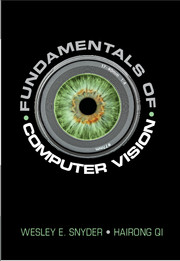Book contents
- Frontmatter
- Dedication
- Contents
- Preface
- For the Instructor
- Part I Preliminaries
- Part II Preprocessing
- Part III Image Understanding
- 8 Segmentation
- 9 Parametric Transforms
- 10 Representing and Matching Shape
- 11 Representing and Matching Scenes
- Part IV The 2D Image in a 3D World
- A Support Vector Machines
- B How to Differentiate a Function Containing a Kernel Operator
- C The Image File System (IFS) Software
- Author Index
- Subject Index
- References
10 - Representing and Matching Shape
from Part III - Image Understanding
Published online by Cambridge University Press: 25 October 2017
- Frontmatter
- Dedication
- Contents
- Preface
- For the Instructor
- Part I Preliminaries
- Part II Preprocessing
- Part III Image Understanding
- 8 Segmentation
- 9 Parametric Transforms
- 10 Representing and Matching Shape
- 11 Representing and Matching Scenes
- Part IV The 2D Image in a 3D World
- A Support Vector Machines
- B How to Differentiate a Function Containing a Kernel Operator
- C The Image File System (IFS) Software
- Author Index
- Subject Index
- References
Summary
Shape is what is left when the effects associated with translation, scaling, and rotation are filtered away.
– David KendallIntroduction
In this chapter, we assume a successful segmentation, and explore the question of characterization of the resulting regions. We begin by considering two-dimensional regions that are denoted by each pixel in the region having value 1 and all background pixels having value 0.We assume only one region is processed at a time, since in studying segmentation, we learned how to realize these assumptions.
When thinking about shapes, and measures for shapes, it is important to keep in mind that certain measures may have invariance properties. That is, a measure may remain the same if the object is (for example) rotated. Consider the height of a person in a picture – if the camera rotates, the apparent height of the person will change, unless, of course, the person rotates with the camera.
The common transformations considered in this chapter are those described by some linear operation on the shape matrix, discussed in section 4.2.3.
In the remainder of this chapter, we will be constantly thinking about operations that exhibit various invariances, and can be used to match shapes of regions.
• (Section 10.2) To understand invariances, we must first understand the deformations that may alter the shape of a region, and most of those can be described by matrix operations.
• (Section 10.3) One particularly important matrix is the covariance matrix of the distribution of points in a region, since the eigenvalues and eigenvectors of that matrix describe shape in a very robust way.
• (Section 10.4) In this section, we introduce some important features used to describe a region. We start from some simple properties of a region like perimeter, diameter, and thinness. We then extend the discussion to some invariant features (to various linear transformations) like moments, chain codes, Fourier descriptors, and the medial axis.
• (Section 10.5) Since, in earlier sections, we have represented the regions by sets of numbers called features, in this section, we discuss how to match such sets of numbers.
- Type
- Chapter
- Information
- Fundamentals of Computer Vision , pp. 218 - 266Publisher: Cambridge University PressPrint publication year: 2017



